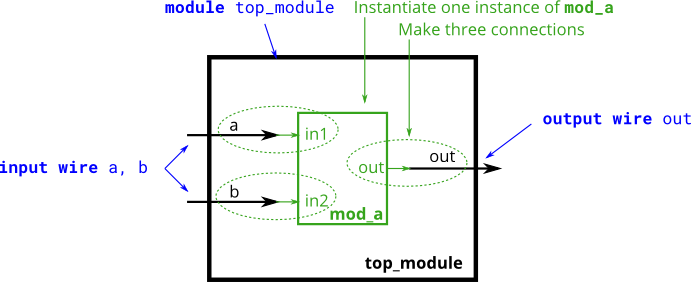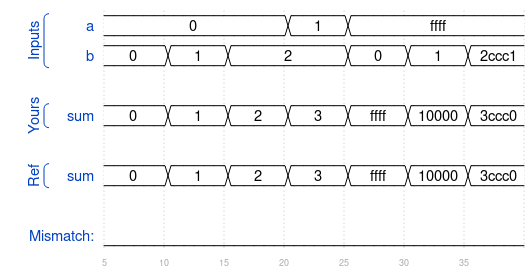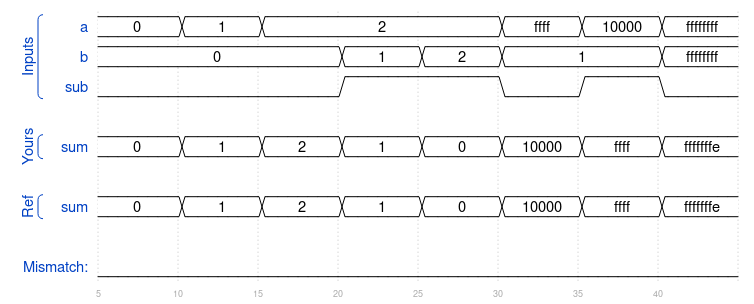HDLBits Module
模块调用

方法
By position
mod_a instance1 ( wa, wb, wc );
通过端口位置一一对应,以此来实现两个模块之间的连接,但当其中一个模块的端口位置发生改变,就需要对相应连接的线进行重新连接。及线连接的对象会因为端口位置的变化而变化。
By name
mod_a instance2 ( .out(wc), .in1(wa), .in2(wb) );
该方法是通过端口名字的一一对应来实现连接,通过该方法就不需要考虑模块端口的位置变化。
实例代码:
//通过位置
module top_module ( input a, input b, output out );
mod_a ins1 (a,b,out);
endmodule
//通过名字
module top_module ( input a, input b, output out );
mod_a ins2 (.in1(a),.in2(b),.out(out));
endmodule
多模块连接
例题

The module provided to you is: module my_dff ( input clk, input d, output q );
代码实现:
//通过名称
module top_module ( input clk, input d, output q );
wire qd1,qd2;
my_dff ins1 (
.clk(clk),
.d(d),
.q(qd1)
);
my_dff ins2 (
.clk(clk),
.d(qd1),
.q(qd2)
);
my_dff ins3 (
.clk(clk),
.d(qd2),
.q(q)
);
endmodule//通过地址
module top_module (
input clk,
input d,
output q
);
wire a, b; // Create two wires. I called them a and b.
// Create three instances of my_dff, with three different instance names (d1, d2, and d3).
// Connect ports by position: ( input clk, input d, output q)
my_dff d1 ( clk, d, a );
my_dff d2 ( clk, a, b );
my_dff d3 ( clk, b, q );
endmodule进阶:

//通过名字
module top_module (
input clk,
input [7:0] d,
input [1:0] sel,
output [7:0] q
);
wire [7:0]out1,out2,out3;
my_dff8 dff1 (
.clk(clk),
.d(d),
.q(out1)
);
my_dff8 dff2 (
.clk(clk),
.d(out1),
.q(out2)
);
my_dff8 dff3 (
.clk(clk),
.d(out2),
.q(out3)
);
always @(*) begin
case (sel)
2'b00: q = d;
2'b01: q = out1;
2'b10: q = out2;
2'b11: q = out3;
endcase
end
endmodule//通过地址
module top_module (
input clk,
input [7:0] d,
input [1:0] sel,
output reg [7:0] q
);
wire [7:0] o1, o2, o3; // output of each my_dff8
// Instantiate three my_dff8s
my_dff8 d1 ( clk, d, o1 );
my_dff8 d2 ( clk, o1, o2 );
my_dff8 d3 ( clk, o2, o3 );
// This is one way to make a 4-to-1 multiplexer
always @(*) // Combinational always block
case(sel)
2'h0: q = d;
2'h1: q = o1;
2'h2: q = o2;
2'h3: q = o3;
endcase
endmodule实现效果:

全加器:
16位*2拼接32位:

module top_module(
input [31:0] a,
input [31:0] b,
output [31:0] sum
);
wire c;
add16 add_1 (
.a(a[15:0]),
.b(b[15:0]),
.cout(c),
.sum(sum[15:0])
);
add16 add_2 (
.a(a[31:16]),
.b(b[31:16]),
.cin(c),
.sum(sum[31:16])
);
endmodule 
并行加法器:

module top_module(
input [31:0] a,
input [31:0] b,
output [31:0] sum
);
wire out,in;
wire [15:0]out1,out2;
assign in = 1;
add16 add_1 (
.a(a[15:0]),
.b(b[15:0]),
.sum(sum[15:0]),
.cout(out)
);
add16 add_2 (
.a(a[31:16]),
.b(b[31:16]),
.sum(out1),
.cin()
);
add16 add_3 (
.a(a[31:16]),
.b(b[31:16]),
.sum(out2),
.cin(in)
);
always @(*) begin
case (out)
1'b0: sum[31:16] = out1;
1'b1: sum[31:16] = out2;
endcase
end
endmodule

加减法器:

module top_module(
input [31:0] a,
input [31:0] b,
input sub,
output [31:0] sum
);
wire [31:0]b2;
wire out;
assign b2 = b ^ {32{sub}};
/*也可以使用如下方法实现xor:
always @(*) begin
case (sub)
1'b0: b2 = b;
1'b1: b2 = ~b;
endcase
end
或者:
assign b2 = sub? (~b):b;
*/
add16 add_1 (
.a(a[15:0]),
.b(b2[15:0]),
.cin(sub),
.cout(out),
.sum(sum[15:0])
);
add16 add_2 (
.a(a[31:16]),
.b(b2[31:16]),
.cin(out),
.cout(),
.sum(sum[31:16])
);
endmodule

最后
以上就是花痴火龙果最近收集整理的关于verilog学习笔记(模块module)HDLBits Module模块调用多模块连接的全部内容,更多相关verilog学习笔记(模块module)HDLBits内容请搜索靠谱客的其他文章。
本图文内容来源于网友提供,作为学习参考使用,或来自网络收集整理,版权属于原作者所有。








发表评论 取消回复